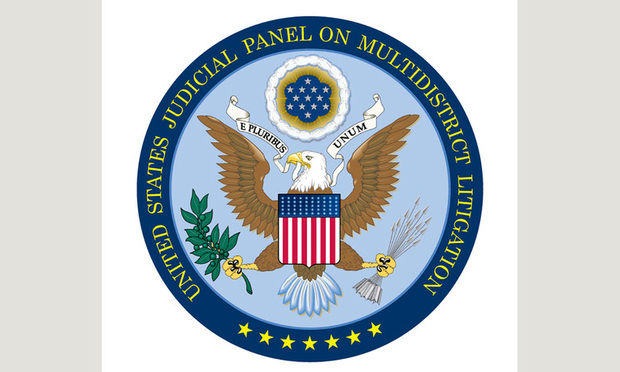Women Attorneys Secure Record Number of Lead Counsel Appointments in MDLs in 2018
According to Law.com data based on federal court records, women took 31 percent of the top MDL positions, both executive committee member and lead counsel combined, compared to 23 percent in 2017.
March 06, 2019 at 11:40 AM
7 minute read
Women made significant strides in securing the top leadership posts of multidistrict litigation, with a record 35 percent of lead counsel roles going to them last year, according to Law.com research and analysis of statistics from the federal judiciary.
The study showed that measure of women leadership far outpaced those reported in 2017, when women made up 21 percent of lead counsel positions in multidistrict litigation. The shift comes as women have been gaining ground in selection for leadership positions of all kinds in multidistrict litigation, particularly in the past four years. Also, 2018 was the first year that white men made up fewer than half of the judges named to preside over MDLs.
“Frankly, we've demanded a seat at the table—that's what's led to the increase in representation of women,” said Roopal Luhana, founding partner of Chaffin Luhana in New York, who was appointed last year to the executive committee of an MDL over Sorin 3T heater-cooler devices used in surgeries. “Personal injury doesn't discriminate, so it better reflect the diverse demographics of the clients as a whole.”
Leadership roles in MDLs give plaintiffs lawyers control over dozens, or sometimes thousands, of cases. That often comes with name recognition and substantial legal fees. For years, the same white and male attorneys repeatedly got appointments to lead MDLs—what some criticized as the “Good Ol' Boys” club.
But, in 2018, women made up 31 percent of all MDL appointments, higher than any prior year, and up from 29 percent in 2017. The figures come from 20 MDLs created in 2018 and excluded seven MDLs in which judges did not appoint plaintiffs' lawyers to leadership positions. They also excluded an MDL involving personal injury lawsuits over firefighting foam in which plaintiffs lawyers on Friday proposed an unopposed slate of 24 attorneys, mostly white men. Should a judge approve that slate, the percentage of women in 2018 would drop to 29 percent again.
But not all appointments are the same—and that's why 2018 stands apart from previous years. In most MDLs, the top positions are co-lead counsel, often assisted by executive committees, which make the overall decisions in the litigation. Secondary positions are those on plaintiffs' steering committees or subcommittees, which handle specific tasks like discovery or trials.
While women have had success in getting secondary positions, men have continued to dominate appointments to executive committees and, even more so, lead counsel positions.
Last year showed that aspect, too, might be changing. Women took 31 percent of both executive committee memberships and lead counsel slots, compared to 23 percent in 2017.
Julie Kane, appointed Aug. 17 as sole lead counsel of an MDL over Monat hair care products, attributed the change to judges seeing more women in the courtroom.
“When a judge is looking for diversity and for talented people who will give him diversity, there's a bigger bench for that judge to choose from,” said Kane of Colson Hicks Eidson in Coral Gables, Florida. “As we continue to treat women more equally, and give women more opportunities, they will slowly and surely rise to the ranks of leadership.”
Kane led a proposal to appoint all women to the Monat hair care MDL—a total of eight attorneys.
“At the time we proposed the slate, we thought this is largely a case about women who've lost a significant amount of their hair because of a product,” she said. “What a wonderful opportunity for a judge to say, 'Yes, there are talented women involved in this case … let's let them take this on.' That being said, the judge picked such brilliant and talented people.”
A competing proposal sought a single lead counsel. U.S. District Judge Darrin Gayles of the Southern District of Florida ended up selecting four people, two from each proposal. Three of them were women, including Kane.
In general, judges are becoming more reluctant to appoint teams that lawyers organize on their own, often behind closed doors, said Rosemary Rivas of San Francisco's Levi & Korsinsky. That might be another reason why more women are getting the top posts.
“Judges are moving away from private ordering to an individual application process where they're hand-selecting attorneys who they believe will best represent the class members,” Rivas said. “As a result of this movement toward an individual application process, more women are applying for these positions.”
That happened in an MDL over alleged security flaws in Intel's microprocessors: U.S. District Judge Michael Simon of the District of Oregon selected 11 lawyers on his own, composed of six men and five women, including Rivas as co-lead counsel. She also got on the executive committee of an MDL against Apple over throttling iPhones.
But in Apple, U.S. District Judge Edward Davila of the Northern District of California appointed an entire slate of 39 attorneys, nine of whom were women. Amy Keller of Chicago's DiCello Levitt & Gutzler, who is on the executive committee, attributed the overall boost in lead counsel roles to plaintiffs firms that recognize the need to put women out front.
“You're seeing these firms promote these women,” she said. “I've seen, in some instances, where women have been proposed as lead counsel, or in a committee in name only, and there's a man partner next to her trying to guide the litigation. And I think a lot of firms are moving away from that, and really trusting women and younger partners to take the reins.”
Judges have increasingly sought diversity in their courtrooms, particularly as those on the bench appointed to lead MDLs have consisted of more women and minorities, said John Rabiej, director of the Bolch Judicial Institute at Duke Law School, which is set to be the venue for a certificate program starting March 13 about leadership appointments in MDLs.
“Lawyers are getting the clear message from the judiciary, and the judiciary is not only talking the talk, but walking the walk,” he said.
One area that remains unchanged is in MDL appointments for minority attorneys, both men and women, who made up six of the 190 leadership appointments in 2018—a few less than last year.
Bev Randles, of Randles & Splittgerber in Kansas City, Missouri, was one of the six. Along with eight other white men, she was appointed last year to lead an MDL over dicamba herbicides in the Eastern District of Missouri. A former defense attorney at Shook, Hardy & Bacon, who founded her own firm in 2013, Randles said it was her first MDL.
“But with this litigation, our firm was the first firm to file any dicamba action in the nation,” she said. “Once we got put into an MDL, it's fair to say there wasn't a question as to whether or not I'd be a member of the executive committee. Our firm had been involved from the inception, and I was the person at our firm leading the charge.”
Minority attorneys, she said, need to make sure to get recognition for their work. She also emphasized that mentors are critical. Lawyers getting the appointments also need to reach outside their “comfort zone,” she said.
“There has to be a sincere desire on the side of the folks who are the decision-makers, and the folks who want to be in higher positions, to make those sorts of things happen,” she said. “If we want these things to change, we have to make the investment of time and resources to do it.”
This content has been archived. It is available through our partners, LexisNexis® and Bloomberg Law.
To view this content, please continue to their sites.
Not a Lexis Subscriber?
Subscribe Now
Not a Bloomberg Law Subscriber?
Subscribe Now
NOT FOR REPRINT
© 2025 ALM Global, LLC, All Rights Reserved. Request academic re-use from www.copyright.com. All other uses, submit a request to [email protected]. For more information visit Asset & Logo Licensing.
You Might Like
View All
4th Circuit Upholds Virginia Law Restricting Online Court Records Access
3 minute read
Plaintiffs Attorneys Awarded $113K on $1 Judgment in Noise Ordinance Dispute
4 minute read
Trump Administration Faces Legal Challenge Over EO Impacting Federal Workers
3 minute read
US Judge Cannon Blocks DOJ From Releasing Final Report in Trump Documents Probe
3 minute readTrending Stories
- 1Midsize Firm Bressler Amery Absorbs Austin Boutique, Gaining Four Lawyers
- 2Bill Would Allow Californians to Sue Big Oil for Climate-Linked Wildfires, Floods
- 3LinkedIn Suit Says Millions of Profiles Scraped by Singapore Firm’s Fake Accounts
- 4Supreme Court Agrees to Hear Lawsuit Over FBI Raid at Wrong House
- 5What It Takes to Connect With Millennial Jurors
Who Got The Work
J. Brugh Lower of Gibbons has entered an appearance for industrial equipment supplier Devco Corporation in a pending trademark infringement lawsuit. The suit, accusing the defendant of selling knock-off Graco products, was filed Dec. 18 in New Jersey District Court by Rivkin Radler on behalf of Graco Inc. and Graco Minnesota. The case, assigned to U.S. District Judge Zahid N. Quraishi, is 3:24-cv-11294, Graco Inc. et al v. Devco Corporation.
Who Got The Work
Rebecca Maller-Stein and Kent A. Yalowitz of Arnold & Porter Kaye Scholer have entered their appearances for Hanaco Venture Capital and its executives, Lior Prosor and David Frankel, in a pending securities lawsuit. The action, filed on Dec. 24 in New York Southern District Court by Zell, Aron & Co. on behalf of Goldeneye Advisors, accuses the defendants of negligently and fraudulently managing the plaintiff's $1 million investment. The case, assigned to U.S. District Judge Vernon S. Broderick, is 1:24-cv-09918, Goldeneye Advisors, LLC v. Hanaco Venture Capital, Ltd. et al.
Who Got The Work
Attorneys from A&O Shearman has stepped in as defense counsel for Toronto-Dominion Bank and other defendants in a pending securities class action. The suit, filed Dec. 11 in New York Southern District Court by Bleichmar Fonti & Auld, accuses the defendants of concealing the bank's 'pervasive' deficiencies in regards to its compliance with the Bank Secrecy Act and the quality of its anti-money laundering controls. The case, assigned to U.S. District Judge Arun Subramanian, is 1:24-cv-09445, Gonzalez v. The Toronto-Dominion Bank et al.
Who Got The Work
Crown Castle International, a Pennsylvania company providing shared communications infrastructure, has turned to Luke D. Wolf of Gordon Rees Scully Mansukhani to fend off a pending breach-of-contract lawsuit. The court action, filed Nov. 25 in Michigan Eastern District Court by Hooper Hathaway PC on behalf of The Town Residences LLC, accuses Crown Castle of failing to transfer approximately $30,000 in utility payments from T-Mobile in breach of a roof-top lease and assignment agreement. The case, assigned to U.S. District Judge Susan K. Declercq, is 2:24-cv-13131, The Town Residences LLC v. T-Mobile US, Inc. et al.
Who Got The Work
Wilfred P. Coronato and Daniel M. Schwartz of McCarter & English have stepped in as defense counsel to Electrolux Home Products Inc. in a pending product liability lawsuit. The court action, filed Nov. 26 in New York Eastern District Court by Poulos Lopiccolo PC and Nagel Rice LLP on behalf of David Stern, alleges that the defendant's refrigerators’ drawers and shelving repeatedly break and fall apart within months after purchase. The case, assigned to U.S. District Judge Joan M. Azrack, is 2:24-cv-08204, Stern v. Electrolux Home Products, Inc.
Featured Firms
Law Offices of Gary Martin Hays & Associates, P.C.
(470) 294-1674
Law Offices of Mark E. Salomone
(857) 444-6468
Smith & Hassler
(713) 739-1250









